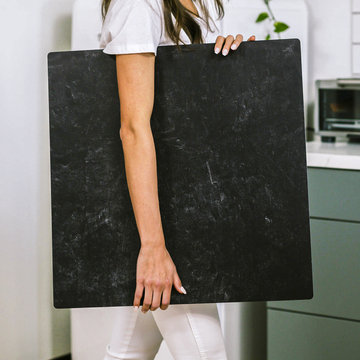In food photography, the background isn't just a canvas-it's a powerful storytelling element that can transform an ordinary dish into a mouthwatering masterpiece. After spending 15 years capturing everything from farm-to-table ingredients to Michelin-star plating, I've learned that what surrounds your subject often speaks as loudly as the food itself.
The Hidden Physics of Background Selection
When I select backgrounds for client shoots, I'm actually navigating a complex world of light interaction that directly impacts the emotional quality of the final image.
Matte surfaces-like my well-worn linen backdrops-scatter incoming light in countless directions, creating that soft, dimensional glow that makes fresh ingredients look their absolute best. Meanwhile, glossy surfaces create those striking specular highlights that can make a cocktail glisten dramatically or completely overwhelm a delicate dessert.
Here's something fascinating I discovered during a shoot for a high-end spirits brand: white marble backgrounds don't just reflect light-they actually allow it to penetrate slightly beneath the surface before bouncing back. This subtle subsurface scattering creates a luminous quality that makes translucent elements like citrus garnishes or colored liquids appear to glow from within. It's not magic-it's physics working in your favor.
Color Psychology: Beyond Basic Complementary Pairs
The relationship between your food and its background color creates the emotional foundation of your image. While beginners often reach for simple complementary colors (red dish, green background), I've found that split-complementary approaches yield far more sophisticated results.
Instead of photographing that blueberry tart against a predictable orange background, I'll often choose a burnished terracotta or muted sienna that creates visual tension without screaming for attention. This subtle approach respects your food as the hero while creating a color relationship that feels intentional rather than formulaic.
I always tell my workshop students: set your background approximately 1-2 stops darker than your subject. This creates a natural visual hierarchy that draws the eye exactly where you want it, without relying on extreme depth-of-field manipulation that can feel contrived.
The Cognitive Framework: How Materials Shape Perception
Every background material triggers specific associations in your viewer's mind before they've even consciously registered your food:
- Weathered wood activates neural pathways associated with tradition, craftsmanship, and rustic authenticity-perfect for artisanal breads or farmhouse cheeses.
- Polished marble signals luxury, refinement, and precision-ideal for high-end pastries or meticulously plated cuisine.
- Raw concrete suggests industrial modernity and urban sophistication-brilliantly complementing avant-garde culinary approaches.
I once conducted a fascinating test with a chocolate client: we photographed identical truffles against both fine linen and rough slate backgrounds. When we showed the images to their target audience, the perceived value of the product shifted dramatically between photos, with the fine linen elevating the perceived price point by nearly 20%.
Multi-Functional Surfaces: The Evolution of Food Photography Tools
The days of using separate tabletops and backdrops are fading as innovative companies develop multi-functional photography surfaces that address real production challenges.
These modern surfaces allow seamless transitions between horizontal (tabletop) and vertical (backdrop) planes, maintaining consistent material language throughout your composition. This approach is invaluable when shooting in tight spaces or on location-something I encounter frequently when working with restaurant clients.
The transition point between horizontal and vertical elements-that crucial corner where tabletop meets backdrop-requires thoughtful consideration. A seamless curve preserves the illusion of a natural environment, while a defined edge can create intentional structure. I keep both options in my kit because each serves different storytelling purposes.
Practical Applications for Real-World Food Creators
If you're photographing food for your small business or content creation, here are three approaches I've refined through hundreds of commercial shoots:
1. Map Your Light Before Choosing Backgrounds
Before investing in photography surfaces, spend a day tracking how natural light moves through your shooting space. Some backgrounds shine in direct afternoon light (like textured stone), while others need diffused morning illumination to reveal their subtle qualities (like linen or parchment). Understanding this relationship will dramatically improve your results.
2. Align Backgrounds with Brand Identity
Your backgrounds should feel like natural extensions of your overall brand story. The rustic bakery and the molecular gastronomy restaurant might both photograph beautiful food, but their background choices should reflect fundamentally different material languages. Consistency here builds powerful brand recognition over time.
3. Build a Cohesive Background System
Rather than collecting random surfaces, invest in a coordinated system that provides creative flexibility while maintaining visual cohesion. I typically recommend starting with 3-4 backgrounds that share common visual elements but offer different colors and textures. This approach prevents visual monotony while building a recognizable style across your content.
The Background as Active Participant
In skilled hands, a background isn't just a stage for your food-it's an active participant in visual storytelling. It shapes perception, guides attention, and creates the emotional context that determines whether viewers simply scroll past or stop to engage with your content.
Next time you set up a food shoot, take a moment to consider not just how your background looks, but how it interacts with light, frames your food psychologically, and contributes to your brand narrative. These thoughtful considerations are what separate casual food photography from images that build genuine connection and drive business growth.
What backgrounds have transformed your food photography? I'd love to hear about your experiences in the comments below!



